Last weekend, the family settled on the couch for “Movie Night,” one of our favorite traditions. Our (well, my) movie pick? Food, Inc., a documentary that “lifts the veil on our nation’s food industry, exposing the highly mechanized underbelly that has been hidden from the American consumer with the consent of our government’s regulatory agencies, USDA and FDA.”
Sounds like a scary movie, right? It was. The night before, BK and I had watched Paranormal Activity, supposedly the scariest movie since The Exorcist, but Food, Inc. was way scarier. And there weren’t even any ghosts.
What was scary was the revelation of how much our government really does control the food industry, and the creepy ways our food is grown (or, more like, made) to be so cheap, fast and easy. One revelation the documentary illustrates is how, thanks to government subsidies, it’s cheaper to feed a family from the drive-through lane at McDonald’s rather than from the checkout lane at the grocery store. But perhaps most horrifying of all were the images of the inhumane treatment of animals.
Let’s just say that 10 minutes into the film, Twin A decided to become a vegan, Twin B was stunned into silence, and Little Miss was crying—no, sobbing—at the sight of little chicks being thrown down a metal chute, each one being bonked in the head with a stamper.
We had to stop the DVD and explain to her what was happening, me silently berating myself for not previewing the film first. Within a few minutes, her tears had dried and she said, “Look, they’re having fun going down the slides; that looks like fun, right?”
“Yeah, it’s a fun slide,” we all chimed in with nervous glances at each other. But then in the next scene, those chicks became chickens, and that neck-holding/head-chopping device didn’t look like any slide I’ve seen, so I covered her eyes. And I wanted to cover my own.
But that’s exactly the problem: Many of us are covering our eyes to where our food is really coming from and how it’s produced. Food, Inc. is a real eye-opener to what’s behind America’s mass production of food, as are several books on the topic, including four bestsellers by Michael Pollan, as well as Eric Schlosser’s Fast Food Nation, Nina Planck’s Real Food: What to Eat and Why, and even the slightly less scholarly but still informative Skinny Bitch by Rory Freedman and Kim Barnouin.
We’re healthy eaters. Right?
In my years as a grown-up, I’ve always considered myself a healthy eater and cook. (I say “as a grown-up,” because like just about every child of the ’70s and ’80s, I had my share of Twinkies, Ding-Dongs, Hamburger Helper and fluorescent foods like Cheetos and Kool-Aid.) But those days are long gone, though the awesome figure they gave me sure isn’t! ![]()
I’ve made sure to do my best to pass on the importance of making healthy food choices to our daughters from the start, from making my own baby food for them, to today making sure they have a fruit and a vegetable at nearly every meal. (And yet, somehow, Little Miss is so anti-veggie that she gags at the smell of broccoli. I have to be sneaky with her.)
We are big label readers. Not so much for the things like fat, sugar and carbohydrates content, although obviously that’s important too, but for what’s actually in the food. You won’t find many things in our kitchen with a giant paragraph of ingredients on the label. We avoid anything with the words “partially hydrogenated,” “high fructose corn syrup,” “monosodium glutamate,” “autolyzed yeast extract,” or really anything we can’t pronounce. And this goes for not just what we put in our bodies, but on them, like lotions, sunscreens, makeup and shampoos, but that’s harder to do. (Hey, I never said I wasn’t vain.)
Some hard-core “real food” fanatics would say I shouldn’t even be buying anything with a label on it in the first place. Ha! I say. You try doing that with a busy household and two preteen girls and a preschooler. Things like frozen waffles, bottled juices and Goldfish crackers are way too convenient to eschew.
We eat organic and locally-grown food when we can (I heart you, Whole Foods!), drink only organic or at least hormone- and antibiotic-free milk (depending on which is cheapest that week), avoid processed foods and preservatives, eat only nitrate-free deli meats, eat tons of probiotic cultures in various forms, eat whole-grain everything always, and 90 percent of our meals are home-cooked and home-eaten. We can count on one hand the times we’ve eaten at McDonald’s or Taco Bell. If we get a craving for that kind of food, we go to In-N-Out Burger or Chipotle, where at least it’s fresh and real.
I’ll admit I do like me a Diet Coke every now and then, but my new favorite afternoon pick-me-up is a cup of green tea sweetened with a splash of agave nectar. The girls rarely drink soda, but when they do it’s usually Hansen’s all-natural. And BK does like his daily espresso (OK, so do I), but the beans he grinds are usually organic.
We even grow some of our own foods, which it turns out you actually can do in the desert:
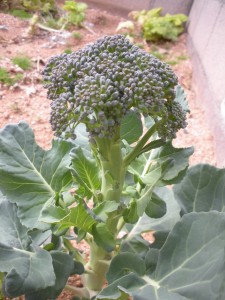 Our beautiful broccoli stalk. Can’t wait to steam this!
Our beautiful broccoli stalk. Can’t wait to steam this!
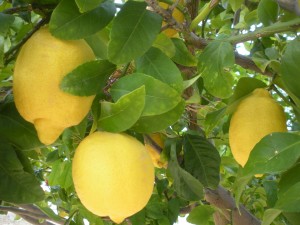
Is there a fruit more versatile than lemons? You can make lemonade, stuff them into a bird, squeeze them onto fish, bake them into treats, even lighten your hair and freckles and clean with them!
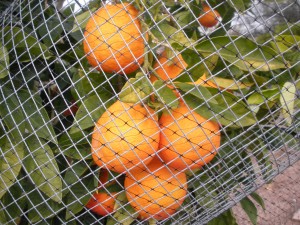
Blood oranges. Ugly name, beautiful fruit. The birds think so, too, thus the netting.
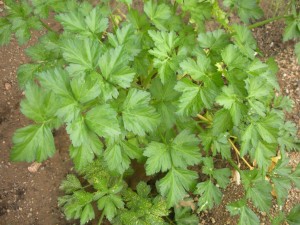
What would we do without parsley?
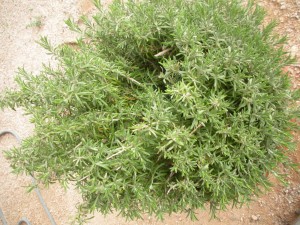
Or rosemary, my focaccia staple?
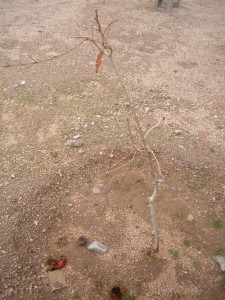
This sad thing doesn't look like much, but it's a dormant pomegranate tree.

This fig tree is also taking it's winter nap. But oh, you should see the figs it gives us for a few weeks each year!
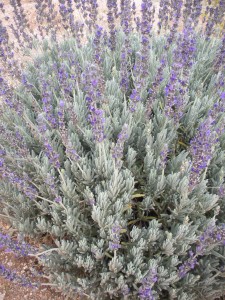
I know this lavendar isn't a food but it's pretty and it smells like a spa.
Room for improvement
OK, so all that being said about how healthily we eat and cook, I know I could do better. Way better. While my kids don’t eat Oreos, Pop-Tarts or Easy Mac, I do buy them the knockoff versions from Whole Foods and Trader Joe’s, which are sweetened with cane juice syrup and organic honey, or flavored with organic sea salt instead of who-knows-what. But in the back of my mind—like in the way back of it—I know that sugar is sugar, and just because it’s a healthier version, it’s still sugar that, like anything, in excess is bad. I know the yogurts I buy are loaded with sugar, especially the “yogurt in a tube” that Michael Pollan says our great-grandmothers would be appalled at and think were toothpaste. In fact, Pollan has a simple rule: “Don’t eat anything your great grandmother wouldn’t recognize as food.”
So am I fooling myself that I’m feeding my family healthy foods?
I substitute ground turkey for ground beef in most recipes, but where did that turkey come from? And what’s been added to it? We don’t eat a lot of red meat, and when we do, we often spring for the organic version. Those cows may have been fed organic corn, but that’s the thing: They should have been fed grass, as nature intended, not corn.
I can’t even begin to cover what Michael Pollan says about that in his books, and in the Food, Inc. documentary.
I will, however, sum up a few of his points that really resonated with me and made me realize that I could be doing better to feed my family healthily, and that I need to delve deeper into my understanding of where our food really comes from and what’s been done to it:
- It’s no surprise that the way Americans eat has changed drastically over the past 50 years. But it was rather surprising to learn that in the 1970s, the top five beef packers controlled only about 25 percent of the market. Today, the top four beef producers control more than 80 percent.
- Despite the fact that there are tens of thousands of products on grocery-store shelves, it’s really only a handful of companies that manufacture and distribute these products. That’s a lot of control in a little bit of companies.
- Today’s technology has allowed a way for chickens to grow from chick to chicken dinner in 49 days instead of the three months that nature intended. That’s just creepy. The documentary makes that point even clearer by showing thousands of drugged-up chickens crowded into a darkened feed lot, some unable to walk or stand because their bodies can’t keep up with the fast growth pace. That’s what happens when the goal of the food industry is “faster, fatter, bigger, cheaper.”
- The government subsidizes the corn, soy and wheat products that are the backbone of the fast-food industry, but do nothing to subsidize fresh produce.
- We Americans spend about 9 percent of our income on food (our high grocery bills disagree with that, though) and more than twice that on health care. It was the other way around 50 years ago.
Of course, food-industry executives say the documentary was biased and misleading, but those same people also declined to be interviewed for the movie. If they had nothing to hide, why not face the cameras?
“Vote with your fork!”
But the bigger question is, what can we do about this clearly unhealthy “fatter, faster, bigger, cheaper” mentality of food production?
Well, we can “vote with our forks,” as Pollan says. What he means by this is that instead of buying our foods from the supermarket (a “treacherous, confusing landscape,” as he calls it), we should buy sustainable, in-season produce and meat that’s been humanely treated from local growers.
Sure, that’s easier for him to say than it is for a lot of us, seeing as he lives in farm-rich, fertile Northern California, and oh, being that he’s a four-time best-selling author, I think he can afford the extra expense.
And it is expensive. Everyone knows that organic is usually more expensive than conventionally grown foods at the grocery store. And for months now, I’ve have an order sheet on my desk for a local farm that sells and delivers real meat from a real farm. The problem is, the cuts of meat and the chickens are smaller than the fatties we’re used to, and they’re more expensive. Plus, they’re frozen since the rancher needs to travel quite a distance to the delivery points.
And these are exactly the problems that we need to fix! First, we need to eat less meat and change our mentality that meat must be the star at the dinner table. That would make it easier to swallow the expense of meat, just like in the olden days when meat was a treat. Second, we need to stop rewarding the feed-lot meat producers who are shooting up the cows and chickens with hormones and antibiotics and then packing who-knows-what into those styrofoam containers, and instead reward these local farmers and ranchers who are doing it right.
So as I’m watching Food, Inc., I’m agreeing with and being enlightened by most of what’s being said. But my question was, how? How in the world, especially in this economy, are enough people going to “vote with their forks three times a day” to make a difference? Isn’t it easier to just sit complacently on the couch, eating a $1.59 bag of chips and drinking a 50-cent can of soda, growing more obese and risking diabetes by the day? Yes, it is easier and cheaper than driving to a farmer’s market or a Whole Foods and coming up with a creative way of putting that food into a decent, nutritious meal.
Sadly, many people just can’t afford the expense or the time to do that. I am fortunate that I can afford to make the time to do it, and as far as the expense, we make food shopping a priority item in the budget. To make up for it, we give up other areas of luxury, such as dining out. Usually, all of us would much rather eat at home anyway, so it works out. (Except on those nights when I don’t feel like cooking.)
After watching the documentary, I thought about a few things we personally could do differently, but that’s just five people. Still, I find it hard to imagine that anyone could watch this without making even just a few little changes, but this wasn’t exactly an Avatar-like blockbuster film that packed the theaters before its DVD release. In order to make a big enough difference, it needed to reach more people, I thought.
The “O Factor”
And then…
A few days after watching the DVD, I heard a promo for Oprah’s upcoming shows. Michael Pollan was coming on her show on Wednesday and they were going to discuss the documentary! The first thing I did was email my friend Sonya, who with her blog, her book recommendations and her creative ways of getting around her family’s food allergies is the one who nudged me to look deeper into this “real food” thing in the first place. The second thing I did was set my DVR to record the show.
This is exactly what was needed! We all know what happens when O endorses a book (immediate bestseller!), a product (can’t find it in stores once it’s been on Oprah), or, oh yeah, a president. Yes, her power is annoying to some, but dang is it ever effective. (By the way, if anyone knows Oprah, please forward her a link to my blog!) ![]()
On the show, she let Pollan do most of the talking. That was probably by design, seeing as the last time she disparaged the beef industry, she ended up fighting (and winning) a major lawsuit. Though she made it clear she wasn’t telling anyone what they should do, she declared that she is going to make more conscious food decisions.
Now for her, that probably means she’s going to tell her personal chefs to seek out local growers and non-feed-lot-type farms that raise animals more humanely. But the rest of us have to do that legwork on our own.
Still, her proclamation will collect a lot of followers and that’s a start. If more people start seeking out better, more humane and healthier ways to eat, the good stuff might become more plentiful, more easily accessible and less expensive, and people will stop rewarding the companies that produce the bad, cheap, fake stuff. Eventually.
Most of what Pollan said on the show was a repeat of the documentary, but a couple of things stood out for me:
- One was that Oprah asked my same question: “How do we feed America without mass producing? It’s the American way!” Unfortunately, Pollan didn’t really answer the question, but rather said that it can be done, and that if we can figure out a way to re-engineer the chicken, we can figure out a way.
- The other was that he stated another one of his rules: “Eat all the junk food you want, as long as you make it yourself.”
Yes! I can do that! I do do that. If we have french fries, cake, cookies or brownies in the house, they’re homemade. I’m so proud that the other day when the girls were at my sister-in-law’s for a sleepover, she made them cupcakes. “Are these from a box mix?” they asked. “And is this frosting canned?” They know the difference between homemade and store-bought, and they much prefer the former, so I must be doing something right, even if some of these treats are loaded with sugar and shortening, right? Sometimes I subsitute applesauce for oil and I usually use whole-wheat flour in place of white.
“Eat food, not too much, mostly plants”
Pollan’s most prevalent rule is one that is so basic and so simple, but yet, not that easy to do: “Eat food, not too much, mostly plants.” Why is that not as easy as it sounds?
For me, for us, it’s a matter of habit. Most of our dinners have always been centered around a meat as the main dish. This meat is almost always chicken breasts or turkey, rarely beef, sometimes fish and never pork. (We’re not Jewish, I just get sick every time I eat pork for some reason.) The chicken is usually an organic, antibiotic- and hormone-free one from Trader Joe’s but I have no idea what it was fed or if it lived on a pasture or in a dark cage. We’ve already started eating less meat, getting our protein from other sources like beans and eggs. But did the chickens that laid those eggs eat grass and bugs along with their grains like they should, or were they fed genetically modified corn and meat by-products? This is the kind of thing I need to look into more.
We do eat a lot of fruits and vegetables, but it’s way easier to buy them from a grocery store rather than trek out to a farmer’s market, and they often don’t taste very good and sometimes look “fake” and all oiled up with who-knows-what.
These are all areas where I know I can do better, but I’m just not sure exactly how.
A way to grow
And then, just like that, good ole Sonya tells me about an eCourse her friend and “real food” mentor Wardeh Harmon is about to teach on exactly this topic. Wardeh has a great website called Gnowfglins, which is an acronym for God’s Natural, Organic, Whole Foods, Grown Locally, In Season. That pretty much sums up what her site is all about, but don’t let that short description fool you. There’s a lot, lot of information there, and the best thing is, she wants to share all that she has learned and gathered about this way of cooking and eating during the past six years in a five-month eCourse she is offering.
This just might be what I need. She says that what she and her family thought was a healthy way of eating six years ago is very different from how they eat now. That’s about where I am right now: I think we’re eating healthily and I think we’re making a lot of healthy choices, and I try to stay educated on the latest health information. But I know I could do better.
I make a lot of our breads from scratch (with a bread machine, don’t be too impressed), I make a lot of homemade soups and stocks, and lately, with our eat-less-meat philosophy, I’ve been soaking and cooking a lot of dried beans (using a Crock-Pot).
But what I don’t do is sprout the grains for the breads or grind my own flour, I don’t make my own water kefir (huh?), I don’t make my own cheese and I don’t know how to naturally pickle foods. And apparently, there’s a whole method to soaking beans and cooking a chicken and making chicken stock that I don’t know about. These are all things Wardeh plans to teach in the eCourse. She’s offering the course on a private website complete with all the multimedia lesson materials and a members-only forum for $27 per month. Right now, she’s offering a giveaway of the course that’s worth a $135 value.
I’m not sure that I will incorporate everything she’ll be teaching into my daily cooking, and I’m not even sure yet why I should, but now that my eyes are open to the creepy, shady ways of the food industry, my mind is also open. I’m willing to learn and try something new. After all, I recently tried kombucha tea and didn’t like it at all. But the point is, I tried it. And now I want to try some new cooking methods, and maybe you would, too.
If so, check out her website. She seems super cool and wise.
I want to be super cool and wise, too, which is why I want to take the course. Well, that and I want my family to eat even more healthily than I thought we already did.
